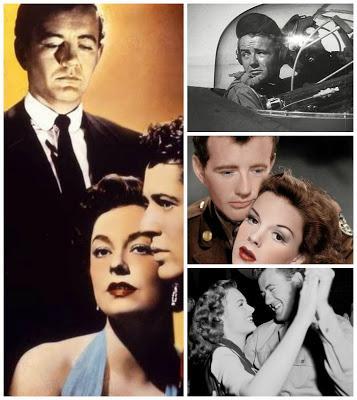
Summer Under the Stars, August 9: Robert Walker
From the New York Times, August 30, 1951: "Los Angeles, Aug. 29 - Robert Walker, 32-year-old film star whose own desperate and protracted struggle with dark emotional forces topped any of his conflicts on the screen, died last night while undergoing medical treatment for the latest of many tragic crises in his life."
Though his film career was cut short by his untimely end, Robert Walker had managed to be credited in 20 films over a nine year stint in Hollywood. Most of these movies are long-forgotten, but two in particular endure: Vincente Minnelli's classic war-time romance, The Clock (1945), with Judy Garland, and one of Alfred Hitchcock's mid-century masterpieces, the suspense thriller Strangers on a Train (1951). Both films are being featured on Sunday, August 9, as part of Turner Classic Movies' Summer Under the Stars day-long tribute to Robert Walker.

Early Years
He was born in Salt Lake City, Utah, on the night of the town's legendary "big fire," October 13, 1918. His father, city editor of the local newspaper, spent exhausting hours covering the inferno while he anxiously awaited the arrival of his fourth child.Robert Hudson Walker would be the last of his parents' children, all boys. And he was a handful. Years later he reflected on his childhood and remarked, "I was an aggressive little character, but what nobody knew but me was my badness was only a cover-up for a basic lack of self-confidence, that I was really more afraid than frightening."When Robert was twelve, his father took a job in Ogden, Utah, some 30 miles from Salt Lake City, and the family moved. On the surface, the change in scenery seemed to have a positive impact on the boy. But not too much time went by before he and an old pal from Salt Lake hopped on a freight train and rode the rails to Las Vegas. He returned home a few days later to find his reputation blackened and, following further hijinks, the boy arrived at the dead end of his parents' patience. But all was not quite lost. Robert's mother had a wealthy sister, his Aunt Hortense, who proposed a solution. Because her plan was far more costly than his mother and father could afford, she offered to finance it herself. And that is when Robert Walker made his first trek to Southern California.
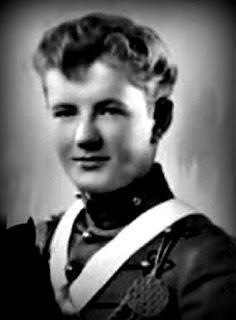
Cadet Robert Walker
The Davis San Diego Army Navy Academy was founded in 1910 but moved to Carlsbad, on the north coast of San Diego County in 1936. Growing up in the "North County" several decades later, I knew of military academy mostly by its reputation as a sort of repository for the problem children - the "bad boys" - of the rich.Robert Walker arrived at Army Navy in 1932 and was, at first, dismayed. Structure and strict discipline left no room for his fitful moods or unpredictable behavior and he had difficulty adjusting. However...like countless kids who eventually find their way to Hollywood, he had years earlier developed a fascination for the theater and had taken to staging his own backyard plays. Channeling his restless energy into these theatrical adventures, he had not only assigned himself starring roles but also directed the other neighborhood children who joined in. Luckily, at Army Navy, Walker rediscovered his appetite for the stage through the school's drama department and it changed his life.
For three consecutive years, Robert Walker took part in county-wide high school drama competitions and won "Best Actor" honors. These successes brought him on-campus celebrity and popularity (he was voted president of the 1936 - 37 senior class) as well as a scholarship offer from the prestigious Pasadena Playhouse. But Aunt Hortense, ready to open her checkbook again, had other ideas.
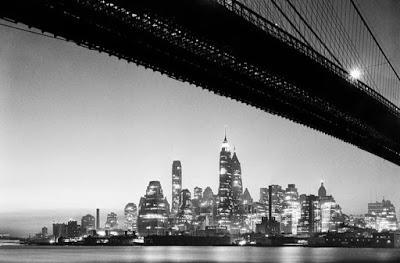
Manhattan, 1938
New York
After commiserating with Hortense about his options, Walker applied to New York's American Academy of Dramatic Arts, one of the foremost schools of its kind in the US. Alma mater to the likes of Spencer Tracy, Edward G. Robinson, Claire Trevor, Kirk Douglas and Jason Robards (and more recently, Jessica Chastain and Adrien Brody), the school was located in the heart of Midtown Manhattan in the Carnegie Hall Building at 7th Avenue and 57th Street. Walker auditioned, was readily accepted ("a boy of fine ability...should develop fully") and, with tuition once again underwritten by Aunt Hortense, he began classes early in 1938.
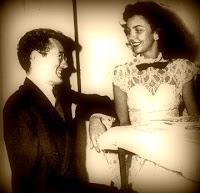
Robert and Phylis Walker
It wasn't long before he met and began practicing scenes with another new student, dark-eyed Phylis Isley of Tulsa, Oklahoma. Soon the pair was rehearsing together exclusively, so convinced was each of the other's talent. Within a year the two would leave the AADA, marry and begin their struggle for careers in the theater.Phylis's quest would be interrupted by the birth of two sons, Robert, Jr., in 1940, and Michael in 1941. As for Robert, he eventually found regular work on-air, becoming an in-demand New York radio actor. Finally financially secure - and with the help of Phyl's wealthy theater-chain-owner father - they were able to hire a housekeeper who helped out with the boys and took over when Phylis went to auditions. The most important audition of Phylis Walker's life came in July 1941, when she auditioned for the title role in the movie adaptation of Claudia, a Broadway hit for which David O. Selznick held the film rights. She quickly became a protégé of the producer of Gone with the Wind and Rebecca who would soon offer her an exclusive 7-year contract.

Fox Carthay Circle movie premiere, 1940s
Hollywood
Robert and Phylis Walker had made an earlier foray to the movie capital shortly after their marriage in 1939. But, with not much more than minor roles and bit parts to show for it, they had gone back to New York. Robert Walker wasn't eager to revisit Hollywood. He didn't see himself as movie material; he didn't have the right looks or build. What he did see was that acting through his voice was something at which he excelled and was well paid for. He was already starring in his own radio show and continued to be sought-after for guest spots on other programs. But he fully supported his wife's career and so, for a while, their marriage was bi-coastal, with Phyl shuttling back and forth from east to west while David O. Selznick plotted her path to stardom.
Walker decided that radio work on the Coast could provide his bread and butter when he and the boys moved west to be with Phyl (re-christened "Jennifer Jones" by Selznick). However, the US had just entered World War II, and so many men in Hollywood had enlisted that there was a dire shortage of movie actors. Since his poor eyesight automatically disqualified him from military service, Robert Walker found studio doors wide open to him when he returned to Hollywood in 1942.
In 1943, he signed on with MGM as a contract player. His first credited film was Bataan (1943), a WWII action movie starring Robert Taylor. It was a promising start. Director Tay Garnett (The Postman Always Rings Twice) was excited about Walker's potential in the role of green recruit Leonard Purkett. "Just play it younger," he advised the 24-year-old, "and you'll be okay. You'll be more than okay. When Purkett goes, I want the audience heartbroken. Bob Taylor is the star of the film, but you can steal it right out from under him - and I'm not handing you any Hollywood bullshit!" Garnett was right, both the picture and Robert Walker were hits with audiences, and the studio rushed him into one of its 4-star prestige projects for 1943, Madame Curie, starring Greer Garson and Walter Pidgeon.
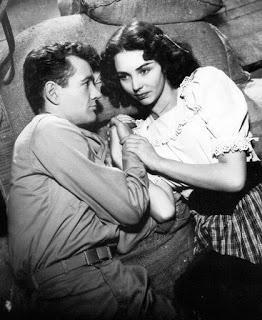
Walker and Jones in Since You Went Away
Shortly, MGM presented him with a 7-year contract and the title role in his next film, See Here, Private Hargrove (1944). Based on a best-seller about a bumbling GI in boot camp, this film, too, was a hit. Meanwhile, Jennifer Jones had finally completed the important film with the star-making role Selznick had been promising her, The Song of Bernadette" (1944). On her next assignment she would play opposite her husband in Selznick's wartime melodrama, Since You Went Away (1944). Life had become very complicated for Jennifer Jones over the last year or so; now it would become that and worse for Robert Walker.Jones was romantically involved with the long-married David O. Selznick but, still idealistic and naïve, Walker had had no inkling. He was convinced his wife's commitment to their marriage and their very young sons was every bit as important to her as her passion for acting and desire for stardom. When she insisted on a marital separation just as Since You Went Away was to start shooting, he was disbelieving - and devastated. This marked the beginning of Robert Walker's painful unraveling. The night he moved out of their home he did something uncharacteristic, he drank himself into a stupor. Then, as production on the film was getting underway, he sustained head injuries in a motorcycle accident. Nothing serious, just enough to aggravate his discomfort. But performing the intimate scenes he and Jones shared onscreen bothered him far more than that, and he soon developed an off-the-set habit of drinking regularly and sometimes heavily.
Elsewhere in Hollywood, Judy Garland was preparing to embark on a film that would boost her career to the next level, Meet Me in St. Louis (1944). She had Robert Walker in mind for the part of John Truett, her character's boy-next-door love interest and requested that he be cast. Walker was willing, but studio head L.B. Mayer nixed the idea. He felt the part was too small and the ensemble cast too large; it would be a backward step for Walker, he believed. Instead the actor was assigned to another WWII film, Mervyn LeRoy's Thirty Seconds Over Tokyo (1944), third billed after Spencer Tracy and Van Johnson. It turned out to be a respected and popular war movie, and, in any case, another chance to work with Judy Garland was on the near horizon.
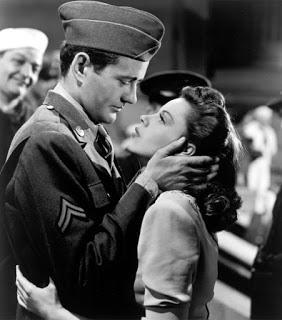
Robert Walker and Judy Garland, The Clock
The Clock (1945) would be a high point in the careers of both Judy Garland and Robert Walker. A romantic melodrama, it tells the story of a young soldier on a two-day leave in New York City where he meets a girl, falls in love and marries her all within the 48-hours before he must return to his post and go to war. It's a poignant tale, ideal for America at that time in that war, boasting not only well-cast stars but also the sensitive direction of Vincente Minnelli. The Clock was a great success, and one of the last of Walker's career highs. In the meantime, Jennifer Jones won a Best Actress Oscar for The Song of Bernadette. On the day following the awards ceremony, she announced that she was seeking a divorce from Robert Walker.Off-screen, Walker was having trouble holding his life together. He was a devoted and loving father to his two boys but he could not get over Jennifer Jones having left him for Selznick, and it continued to rankle, deeply. He'd developed a drinking problem and some said he was suicidal. When it came to his career at MGM, he was feeling increasingly disaffected. He balked at the studio edict that stars take part in Hollywood's social whirl and was beginning to grumble about the films and roles he was being assigned. As time went on and his behavior became more erratic, his life became fodder for the tabloids. First, he went missing for several days during a film production and his disappearance became a nationwide news story. After an evening out drinking, he sideswiped a truck on the way home and was later charged with hit-and-run driving. He fell into a casual affair with Ava Gardner that came to an ugly, much-gossiped-about end. Then he married and divorced director John Ford's daughter, Barbara, in less than six weeks.
When Dore Schary took over as head of production at MGM, Walker met with him and came away feeling hopeful and positive about his career. Then, soon after, he was arrested for being drunk and disorderly. He continued to be unruly at police headquarters and a photo of him in custody, scowling into the camera, appeared in newspapers everywhere. Finally, MGM had had enough. Dore Schary gave him the choice of either tearing up his contract or checking into the Menninger Clinic for psychiatric evaluation and, hopefully, treatment. Walker opted for the clinic, and his stay would last for months.
Hitchcock
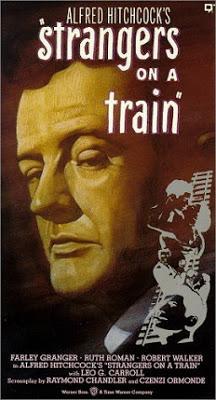
Hitchcock was about to set to work on a new film for Warner Brothers. The screenplay would be adapted from the first novel of a new writer, Patricia Highsmith (The Talented Mr. Ripley), titled Strangers on a Train. With this story, Hitchcock would once again examine duality, a theme that endlessly intrigued him.
"There's also a person exactly the opposite of you, like the unseen part of you, somewhere in the world, and he waits in ambush."
~ Patricia Highsmith, Strangers on a Train
In Hitchcock's film, the two strangers who meet on a train are Guy Haines, a famed tennis player, and Bruno Anthony, a smooth-talking wastrel. They really don't have very much in common, but over lunch and with drinks they find there is one thing: each has someone in his life he'd like to be rid of. Guy would like to divorce his trampy wife, but she won't hear of it, and Bruno would like to be free of the powerful and fed-up father who pays his way in life. Guy doesn't give much thought to this coincidence, but Bruno is excited by it.
Bruno is the villain of the piece and, as Mr. Hitchcock once famously said to Mr. Truffaut, "the more successful the villain, the more successful the picture..." There was only one actor Hitchcock had in mind for the role of Bruno Anthony and that was Robert Walker. Walker was flattered that Hitchcock wanted him and was, of course, interested in working with him. He was even more interested when the director sent him a copy of Highsmith's book with a note: "To help you get under the skin of the weirdo you'll be playing."
The weirdo Walker would be playing was the antithesis of a type he had played for years, the innocent, good-hearted boy-next-door. And Bruno couldn't have been more different from the sweet, considerate Robert Walker beloved by just about everyone who knew him. At the same time, Walker was an accomplished actor and, having spent plenty of time in the dark recesses of his psyche, he knew what it was to wrestle with powerful demons.
With the role of Bruno Anthony, Robert Walker was at last able to demonstrate onscreen and for posterity, the depth of a talent that had never truly been mined until then. Friendly and ingratiating, smart and quick, mean and murderous, Walker's Bruno is simultaneously attractive and repellent. And he owns the screen. It is a performance for the ages in one of the great Hitchcock masterpieces.
Robert Walker lived long enough to know that his reviews were raves and that Strangers on a Train was a runaway hit. It was the film that revived Hitchcock's career and launched his "golden decade." It might have reinvigorated Walker's career, too, but there just wasn't enough time.
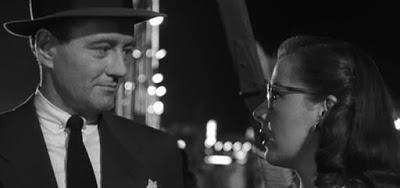
Robert Walker and Kasey Rogers in Strangers on a Train
Kristen of Journeys in Classic Film is hosting this year's Summer Under the Stars Blogathon. Click here for participating blogs!
Click here for a link to the full schedule of Robert Walker films to be shown on August 9 on TCM.
~
References:Star-Crossed: The Story of Robert Walker and Jennifer Jones by Beverly Linet (G.P. Putnam's Sons, 1986)Showman: The Life of David O. Selznick by David Thomson (Alfred A. Knopf, 1992)


